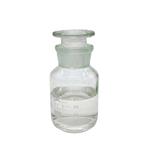Methyl pyruvate is a clear, light yellow, and flammable
liquid.
Methyl pyruvate may be used to investigate the adsorption and reactivity of methyl pyruvate on Pt{111}. It may be used in the preparation of dimethyl 2,3-dimethylenebutanedioate.
Methyl Pyruvate acts as a potent secretagogue used in the study of stimulus-secretion coupling. Also used in the preparation of quinoxalines as dual phoosphodiesterase 2/10 (PDE2/10) inhibitors. It increases free calcium ion concentration in the cytosol of pancreatic cells. It is used in the preparation of dimethyl 2,3-dimethylenebutanedioate.
Methyl pyruvate has been prepared from the silver salt of pyruvic acid and methyl iodide; from the free acid, by the ethanol-vapor method without a catalyst, by azeotropic removal of the water produced by the reaction of methanol in the presence of p-toluenesulfonic acid (the present method), and by refluxing with methanol in ethylene dichloride using ethanesulfonic acid as a catalyst (73% yield). Pyruvic esters have also been prepared by the catalytic dehydrogenation of lactic acid esters and by the oxidation of ethyl lactate with potassium permanganate.
DOI:
10.15227/orgsyn.024.0072
ChEBI: Methyl pyruvate is a pyruvate ester resultinf grom the formal condensation of the carboxy group of pyruvic acid with the hydroxy group of methanol. It is a pyruvate ester and a methyl ester. It derives from a pyruvic acid.
Methyl pyruvate is a pyruvic ester. Surface conditions during Pt/silica EUROPT-1 modified by cinchonidine catalyzed by enantioselective hydrogenation of methyl pyruvate to R-(+)-methyl lactate were investigated. Enantioselective hydrogenation of methyl pyruvate over finely dispersed polyvinylpyrrolidone-stabilized and the corresponding alumina-supported iridium clusters modified with cinchonidine was studied. The molecular orientation and conformation of methyl pyruvate on Ni(111) surface has been investigated in the temperature range 105-220K. Methyl pyruvate is reported to stimulate insulin secretion in vitro and in vivo.



